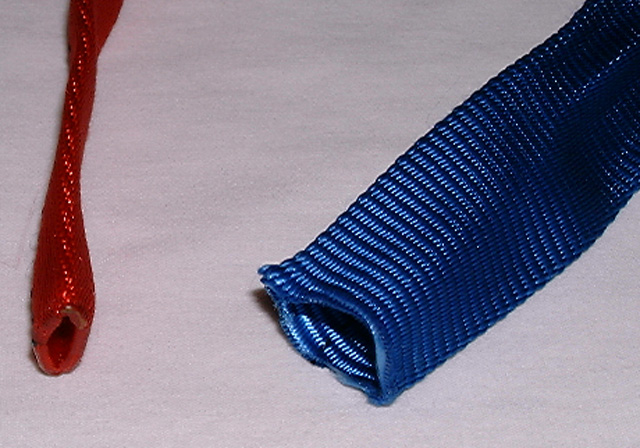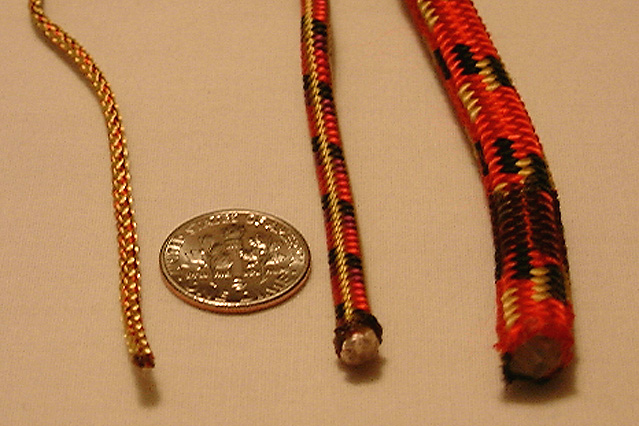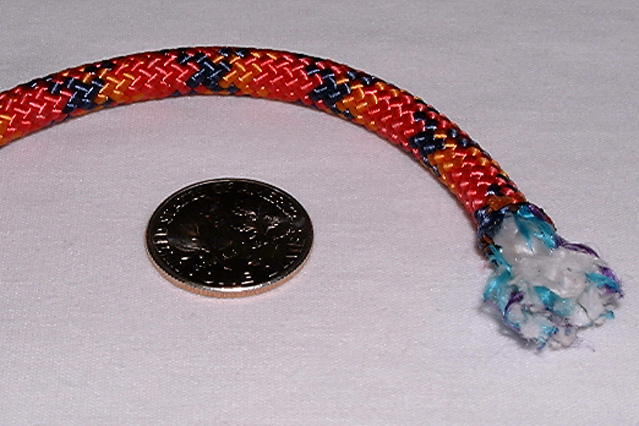There are many types of webbing and small rope that can be used to connect your rocket’s recovery system; each one has its benefits and drawbacks. This article covers the types of rope, cord, and webbing that are used in climbing and applies them to high power rocketry.
Tubular Nylon
Tubular nylon is a tube of woven nylon that normally lays flat. It is more than twice as strong as the same width of non-tubular nylon webbing, yet it has almost the same thickness. Contrary to popular belief, tubular webbing only stretches a tiny amount, if at all. It is not intended to take a shock load, which, in this case, happens to be two rocket parts almost coming to a stop from a high velocity. While the tubular nylon will handle the force until it reaches it’s breaking point, the object it is connected to might not. This is not to say tubular nylon should not be used. On the contrary, it is used quite often due to its immense strength and reliability. Below is a table showing four of the most common webbing and each type’s specifications, including approximate price.

| Size (inch) | Strength (kN) | Wt./ft (g) | Approx. Price/ft* |
|---|---|---|---|
| 9/16 Military Spec. | 6.8 | 5.7 | $0.22 |
| 9/16 Climb Spec. | 10.2 | 7.9 | $0.22 |
| 1 | 18.1 | 11 | $0.30 |
| 2 | 30.0 | 25 | $0.55 |
The price is approximate and listed for comparison only.
Accessory Cord
Accessory cord varies in size from 2mm through 8mm in diameter with the 4mm and up sizes rated for strength. While not as strong as webbing, accessory cord tends to stretch a little more, probably because it takes less force to reach a higher percentage of it’s maximum strength. One of the two advantages of using accessory cord is its round shape, which make it easier to tie knots in. The second advantage is the natural fit into standard oval quick-links compared to webbing. Below is a table showing various types of accessory cord and each type’s specifications, including approximate price.

| Brand | Size (mm) | Strength (kN) | Wt./ft (g) | Approx. Price/ft* |
|---|---|---|---|---|
| Mammut | 2 | N/A | N/A | $0.15 |
| Mammut | 3 | N/A | N/A | $0.15 |
| Mammut | 4 | 3.7 | 3.0 | $0.20 |
| Mammut | 5 | 5.6 | 5.5 | $0.25 |
| Mammut | 6 | 8.0 | 7.0 | $0.30 |
| Mammut | 7 | 10.8 | 9.1 | $0.40 |
| Mammut | 8 | 15.5 | 12.1 | $0.50 |
| PMI | 3 | N/A | N/A | $0.15 |
| PMI | 4 | 3.3 | 3.4 | $0.20 |
| PMI | 5 | 5.5 | 6.3 | $0.25 |
| PMI | 6 | 6.8 | 7.4 | $0.30 |
| PMI | 7 | 9.3 | 8.9 | $0.40 |
The price is approximate and listed for comparison only.
Spectra Cord
Spectra cord comes in 2.0mm and 5.5mm diameters and is much like Kevlar in its properties. Spectra will not melt or stretch and is extremely strong for it’s size and weight. It is so strong, climbing manufacturers routinely say it is 10 times stronger than steel. What makes this cord different is that the spectra fibers are on the inside with a nylon sheath woven over them to protect them from abrasion. Note: The spectra cord is relatively stiff and slick, because of this, only a triple fisherman’s knot is recommended to tie it with. Below is a table showing three different types of spectra cord and each type’s specifications, including approximate price.

| Brand | Size (mm) | Strength (kN) | Wt./ft (g) | Approx. Price/ft |
|---|---|---|---|---|
| Kelty† | 2 | 0.8 | N/A | $15/50ft |
| Blue Water | 5.5 | 17.8 | 4.8 | $1.05 |
| Maxim | 5.5 | 17.8 | 5.9 | $1.05 |
† The Kelty spectra cord is sold as tent guy lines. It comes with a reflective band sewn into its nylon sheath and only comes in 50ft lengths.
The price is approximate and listed for comparison only.
Dynamic Rope
This type of rope is specifically engineered to absorb shock loads. It is not rated for strength; instead it is rated based on how many simulated climber falls it can handle before stretching beyond a certain limit. Essentially, this rope will not break; it stretches. However, it is not bungie because it only stretches roughly 5% of it’s total length for a huge impact force (~ 3000lbf). While not sounding like much, this 5% stretch significantly reduces the impact force that would be felt by a rocket. Dynamic Ropes’ major drawbacks for rocketry are that it’s only available in larger diameters (7.8-11mm) and a minimum length of 164 feet, which result in a high price.
All the information for the tables came from the 1999 REI Climb Information Guide. To purchase any of the above materials visit your local climbing/outdoor store or visit REI online.
Submitted by: Bryan Flynt